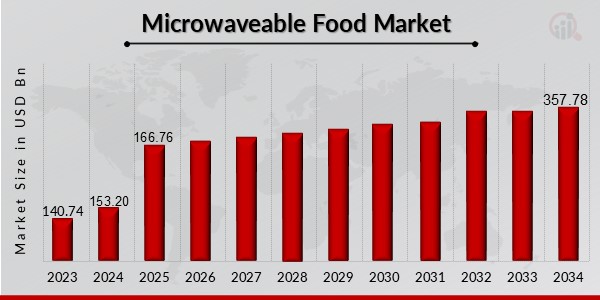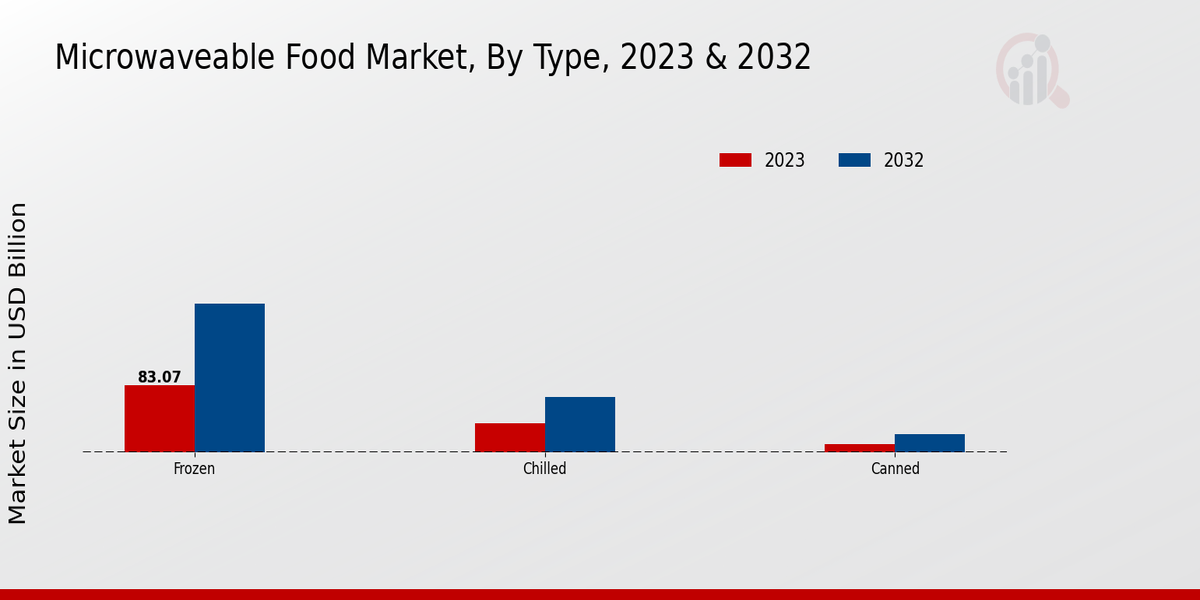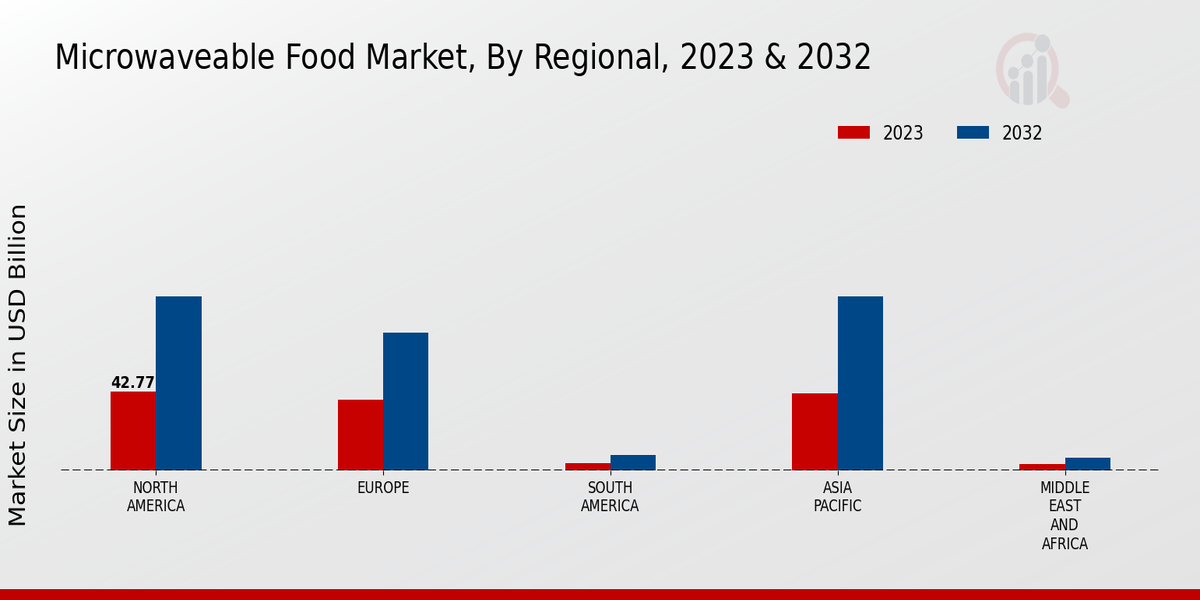Global Microwaveable Food Market Overview
Microwaveable Food Market Size was estimated at 153.20 (USD Billion) in 2024. The Microwaveable Food Industry is expected to grow from 166.76(USD Billion) in 2025 to 357.78 (USD Billion) by 2034. The Microwaveable Food Market CAGR (growth rate) is expected to be around 8.9% during the forecast period (2025 - 2034).

Source Primary Research, Secondary Research, MRFR Database and Analyst Review
Key Microwaveable Food Market Trends Highlighted
Surging disposable incomes, increasing urbanization, and growing acceptance of convenience foods are the key factors supporting the microwaveable food market. The demand for these foods is likely to remain high in future years as people become more starved for time and, therefore, opt for simpler and quicker meal preparations.
Some of the opportunities that can be leveraged in the microwaveable food industry include venturing into fresh and innovative product development, expansion in untapped regions, and adoption of eco-friendly packaging techniques. Businesses may also consider developing microwaveable meals targeted at consumers with specific dietary restrictions that include gluten-free, low-carb, or vegetarian meals.
In the microwaveable food market, some of the new developments include meal kits aimed at working professionals, growing demand for fresh ingredients, and increased emphasis on eco-friendly packaging. Meal kits are sold to consumers with all the ingredients required, along with easy recipe instructions for cooking in a somewhat homemade style. There is also increasing demand for fresh and healthy meals as most women are also getting concerned about their health. Last but not least, microwaveable food packaging solutions that are more sustainable are also a major trend today owing to the increasing environmental awareness among consumers.
Microwaveable Food Market Drivers
Growing Demand for Convenience and Time-Saving Solutions
In today's fast-paced world, consumers are increasingly seeking convenient and time-saving solutions for their daily meals. Microwaveable foods offer a perfect solution, as they can be quickly and easily prepared in just a few minutes. This has led to a surge in demand for microwaveable food products, particularly among working professionals, students, and families with busy schedules. The convenience factor is expected to remain a key market driver in the coming years as consumers continue to prioritize time efficiency and ease of preparation.
Rising Health Consciousness and Demand for Healthier Options
Consumers are becoming increasingly health-conscious and are seeking healthier food options. Microwaveable food manufacturers are responding to this demand by introducing healthier products, such as low-calorie, low-fat, and organic microwaveable meals. These healthier options are often made with fresh ingredients and are free from artificial preservatives and additives. The growing demand for healthier microwaveable food products is expected to drive market growth in the coming years.
Technological Advancements and Innovation
Technological advancements are also playing a key role in driving the growth of the Microwaveable Food Market Industry. For instance, the development of innovative packaging solutions has enabled manufacturers to extend the shelf life of microwaveable foods, making them more convenient for consumers. Additionally, advancements in microwave technology have led to the development of more efficient and user-friendly microwave ovens, which further enhance the convenience factor.
Microwaveable Food Market Segment Insights
Microwaveable Food Market Type Insights
The Microwaveable Food Market is segmented by Type into Frozen, Chilled, and Canned. Frozen microwaveable foods accounted for the largest market share in 2023 and are expected to continue to dominate the market over the forecast period. Frozen microwaveable foods offer a number of advantages over other types of microwaveable foods, including longer shelf life, ease of storage, and convenience. Frozen microwaveable foods can be stored in the freezer for months and can be reheated quickly and easily in the microwave. This makes them a convenient option for busy consumers who want a quick and easy meal.Chilled microwaveable foods are the second largest segment of the market. Chilled microwaveable foods have a shorter shelf life than frozen microwaveable foods, but they offer a number of advantages, including a fresher taste and texture. Chilled microwaveable foods are typically made with fresh ingredients, and they are not subjected to the same freezing and reheating process as frozen microwaveable foods. This results in a more flavorful and satisfying meal. Canned microwaveable foods are the smallest segment of the market. Canned microwaveable foods offer a number of advantages over other types of microwaveable foods, including a long shelf life and ease of storage.Canned microwaveable foods can be stored in the cupboard for months, and they can be reheated quickly and easily in the microwave. The growth of the market is being driven by a number of factors, including increasing consumer demand for convenience foods, rising disposable income, and growing awareness of the health benefits of microwaveable foods.

Source Primary Research, Secondary Research, MRFR Database and Analyst Review
Microwaveable Food Market Packaging Insights
The Microwaveable Food Market is segmented based on Packaging into Trays, Bowls, and Bags. Trays hold the largest market share and are expected to continue dominating the market in the coming years. The convenience of trays in terms of easy handling, stackability, and microwavable makes them a preferred choice for manufacturers and consumers. Bowls, on the other hand, offer better heat retention and are ideal for soups, stews, and other liquid-based microwaveable foods. Bags are gaining popularity due to their lightweight and space-saving properties, making them suitable for on-the-go consumption.The Microwaveable Food Market revenue for Trays in 2023 was valued at USD 45.68 Billion and is projected to reach USD 75.42 Billion by 2032, exhibiting a CAGR of 6.2%. The market for Bowls is expected to grow from USD 32.14 Billion in 2023 to USD 53.21 Billion by 2032, registering a CAGR of 6.5%. Bags are anticipated to witness the fastest growth, with a CAGR of 7.1%, reaching a market value of USD 23.76 Billion by 2032 from USD 15.47 Billion in 2024.
Microwaveable Food Market Meal Category Insights
The Meal Category segment of the Microwaveable Food Market is expected to witness significant growth in the coming years. The 'Main Courses' category is projected to hold the largest market share, driven by the increasing demand for convenient and time-saving meal options. The 'Snacks' category is expected to grow at a rapid pace, fueled by the rising popularity of on-the-go snacking. The 'Desserts' category is also anticipated to experience steady growth as consumers seek indulgent and convenient dessert options. The 'Side Dishes' category is expected to grow moderately, supported by the increasing demand for complementary dishes to accompany main courses.Overall, the Meal Category segment is expected to contribute significantly to the Microwaveable Food Market revenue, which is projected to reach $140.22 billion by 2024, exhibiting a CAGR of 8.9% during the forecast period.
Microwaveable Food Market Distribution Channel Insights
The Microwaveable Food Market is segmented by distribution channel into retail and foodservice. The retail segment is expected to account for a larger share of the market in 2023, owing to the growing popularity of convenience foods and the increasing number of retail stores. The food service segment is also expected to grow at a significant rate, driven by the increasing demand for microwaveable foods in restaurants and other food service establishments. In 2023, the retail segment of the Microwaveable Food Market is expected to be valued at USD 129.29 billion.The growing popularity of e-commerce is also expected to contribute to the growth of the retail segment. Key factors driving the growth of the foodservice segment include the increasing demand for microwaveable foods in restaurants and other food service establishments, the growing number of tourists, and the increasing popularity of microwaveable foods as a convenient and affordable meal option.
Microwaveable Food Market Regional Insights
The regional segmentation of the Microwaveable Food Market offers valuable insights into the market's geographic distribution and growth potential. North America held a significant market share in 2023, driven by the high adoption of convenience foods and the presence of major market players. Europe is another key region, with a growing demand for microwaveable meals due to busy lifestyles and increasing disposable incomes. APAC is expected to witness substantial growth over the forecast period, owing to the rising urbanization, expanding middle class, and changing consumer preferences.South America and MEA represent emerging markets with untapped potential, offering opportunities for market expansion.

Source Primary Research, Secondary Research, MRFR Database and Analyst Review
Microwaveable Food Market Key Players And Competitive Insights
There is a high level of competition among various leaders in the Microwaveable Food Market that are focused on launching innovative products and widening their distribution networks. In other words, this branch is characterized by a high level of competition, and the key companies in the Microwaveable Food Market employ different strategies to ensure that their clients are interested in their products. For this reason, such strategies as partnerships and collaborations are usually practiced due to the fact that companies can use peculiar advantages of each other. Besides, it is evident that competition in the offered sector will be high in the future as well, and new companies, as well as technologies that are more advanced, have a chance to emerge.
Nestle SA is one of the main players in the related sector that sells microwaveable food in different countries, including, among others, the United States. It tries to use as many innovations as possible in order to not only satisfy its clients but also ensure that its products are perceived as a healthy choice. Moreover, the company has a wide distribution network and a good brand image that can be considered as the main strength of the company. Its activity is defended by the high level of corporate social responsibility, and the fact that the company is focused on sustainability has a positive impact on its image and perception.
Tyson Foods, Inc. is another important player in the sector that produces different microwaveable meals, mainly from proteins. This brand, which is mainly active in the United States, is mainly known for its level of quality. It is very important that the brand, in general, is interested in satisfying different consumer needs by launching microwaveable meals varying in terms of types and compositions. What is more, the brand is focused on innovation in the field and tries to use different tools, including customer analytics, to remain competitive. Moreover, the commitment to food safety and animal welfare also has a positive impact on the activity of the brand, which adds to its strength.
Key Companies in the Microwaveable Food Market Include
- Lamb Weston Holdings, Inc.
- Mondelez International, Inc.
- The J.M. Smucker Company
- The Kraft Heinz Company
- Conagra Brands, Inc.
- Hormel Foods Corporation
- CSM Ingredients
- General Mills, Inc.
- Unilever PLC
- Ajinomoto Co., Inc.
- Kraft Heinz Company
- PepsiCo, Inc.
- McCain Foods Limited
- ADM
- Nestlé S.A.
Microwaveable Food Market Industry Developments
The microwaveable food market is projected to grow from USD 129.29 billion in 2024 to USD 277.3 billion by 2032, exhibiting a CAGR of 8.85% during the forecast period. Rising disposable incomes, busy lifestyles, and increasing demand for convenience food are driving market growth. Key industry participants are focusing on product innovation and expanding their distribution networks to cater to the evolving consumer preferences for healthy and flavorful microwaveable meals. Recent developments include the launch of plant-based microwaveable meals by major brands, such as Nestle and Unilever, and the growing popularity of meal delivery services that offer microwaveable options. Additionally, advancements in packaging technology are enabling the development of microwaveable meals with extended shelf lives and improved nutritional content.
Microwaveable Food Market Segmentation Insights
- Microwaveable Food Market Type Outlook
- Microwaveable Food Market Packaging Outlook
- Microwaveable Food Market Meal Category Outlook
- Main Courses
- Side Dishes
- Snacks
- Desserts
- Microwaveable Food Market Distribution Channel Outlook
- Microwaveable Food Market Regional Outlook
- North America
- Europe
- South America
- Asia Pacific
- Middle East and Africa
| Report Attribute/Metric |
Details |
| Market Size 2024 |
153.20(USD Billion) |
| Market Size 2025 |
166.76(USD Billion) |
| Market Size 2034 |
357.78(USD Billion) |
| Compound Annual Growth Rate (CAGR) |
8.9% (2025 - 2034) |
| Report Coverage |
Revenue Forecast, Competitive Landscape, Growth Factors, and Trends |
| Base Year |
2023 |
| Market Forecast Period |
2025 - 2034 |
| Historical Data |
2019 - 2023 |
| Market Forecast Units |
USD Billion |
| Key Companies Profiled |
Lamb Weston Holdings, Inc., Mondelez International, Inc., The J.M. Smucker Company, The Kraft Heinz Company, Conagra Brands, Inc., Hormel Foods Corporation, CSM Ingredients, General Mills, Inc., Unilever PLC, Ajinomoto Co., Inc., Kraft Heinz Company, PepsiCo, Inc., McCain Foods Limited, ADM, Nestlé S.A. |
| Segments Covered |
Type, Packaging, Meal Category, Distribution Channel, Regional |
| Key Market Opportunities |
Ready-to-eat meals Growing demand for convenience Innovation in packaging Health-conscious options Expansion into emerging markets |
| Key Market Dynamics |
Increasing demand for convenience Rising health consciousness Technological advancements Growing disposable income Product innovation |
| Countries Covered |
North America, Europe, APAC, South America, MEA |
Frequently Asked Questions (FAQ) :
The microwaveable food market was valued at USD 166.76 billion in 2025 and is expected to reach USD 357.78 billion by 2034, exhibiting a CAGR of 8.9% during the forecast period.
North America and Europe are the dominant regions in the microwaveable food market, accounting for a significant share of the revenue. Asia-Pacific is expected to witness the fastest growth during the forecast period due to rising disposable income and changing lifestyles.
Microwaveable food finds applications in various settings, including households, offices, and educational institutions. It offers convenience and time-saving benefits, making it a popular choice for busy individuals and families.
Major players in the microwaveable food market include Nestle, Kraft Heinz, Conagra Brands, and Unilever. These companies offer a wide range of microwaveable food products, including frozen meals, snacks, and side dishes.
Rising demand for convenience food, increasing disposable income, and advancements in packaging technology are key factors driving the growth of the microwaveable food market.
Concerns regarding the nutritional value and health implications of microwaveable food, as well as competition from fresh and home-cooked meals, pose challenges to the growth of the market.
The Asia-Pacific microwaveable food market is projected to grow at a CAGR of 10.2% during the forecast period, owing to rapid urbanization, changing dietary habits, and increasing penetration of microwave ovens.
The microwaveable food market is segmented based on product type, including frozen meals, ready-to-eat meals, snacks, and side dishes. Frozen meals hold the largest market share due to their convenience and variety.
The microwaveable food market is segmented based on distribution channels into supermarkets and hypermarkets, convenience stores, online retailers, and food service outlets. Supermarkets and hypermarkets account for the majority of the market share.
In North America, the growth of the microwaveable food market is driven by factors such as the increasing number of working professionals, rising disposable income, and the popularity of convenience food options.

















